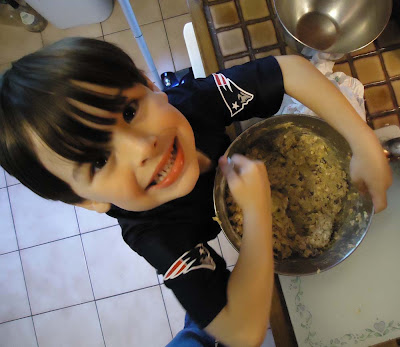





If you have a crockpot and some blankets, you can make yogurt. From start to finish, this is about a 14 hour process but there is very little work involved and most of it happens while you are sleeping.
Items Needed:
1 crock pot. Any size will do but one that can hold about a gallon of milk is good.
Powdered milk (optional)
6-8 ounces of plain yogurt for starter (or one cup reserved from last batch) OR powdered yogurt starter.
Blankets
Strainer
Cloth to strain it
At 4:30 PM, I filled my crock pot with milk until about a half inch from the top. It should take most of a gallon of milk with a standard sized pot. I added one cup of powdered milk and stirred it in. This step is not necessary but I've found it does make the yogurt a little thicker if you aren't using whole milk. I used 1% for this. I put the cover on and turned it on low and let it sit for 3 hours.
At 7:30 PM, I turned off and unplugged the crock pot. That's it. Then it sat for another three hours. Easy?
10:30 PM: I removed 2 cups of the still warm milk and stirred in my yogurt starter. This time I used 1 cup of plain yogurt. You can buy it in the store or use a frozen cup from your last homemade batch. I stirred in the yogurt with the two cups warm milk and poured it back into the crock pot and stirred again. I put the lid back on and wrapped the whole pot in blankets (I used three medium sized ones). Remember that the crockpot is still unplugged.
Then I watched a documentary and went to bed. You can leave it overnight for 8-10 hours. 10 hours will set it a little nicer but 8 is sufficient. It is not dangerous to leave the milk sitting warm overnight so don't worry about that. Remember that in much of the world, yogurt is consumed at room temperature.
7:30 AM: I lined a collander set over a large pot with white cloth and scooped the yogurt in to drain for a few hours. Put the straining yogurt in the fridge at this point. While it's fine to consume right now, it wouldn't be safe to continue to store it on the counter for more than a day. The picture shows only a little in the cloth but the yogurt I poured in filled the whole colander.
The first time I made yogurt I had to play with it a little before I put it in the strainer. I was so amazed that the spoon cut through it. I almost didn't believe the process would work and was fascinated when it did!
The amount of straining time depends on how thick you like your yogurt. I let this batch sit in the fridge for 3 hours. I then scooped it into a glass container and stirred the contents. I also reserved a cup of it for my freezer to make another batch. The yogurt closest to the cloth will be very thick. This is the start of yogurt cheese (my dad has made me strained yogurt sprinkled with mint to eat on Syrian bread and it's delicious. You can use it like cream cheese and it's better for you too). You can leave a bit of the yogurt to strain more if you want to keep a pot of yogurt cheese in your fridge. I'd probably leave it overnight for good results.
What's left in the pot after straining is the whey. Don't throw this away if you want a great source of protein to use as a substitute for water or milk in baking or smoothies. I got about 5 cups of whey this time and froze most of it. I'll probably make muffins with some of the whey tonight.
I really like homemade yogurt with a little maple syrup on it, but you can put whatever you like in it. Use it no differently than store bought plain yogurt. It's really delicious and economical and you'll be so excited when you first try it and watch that spoon drag in the morning!



















